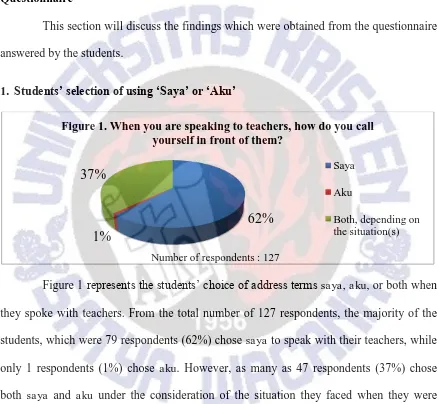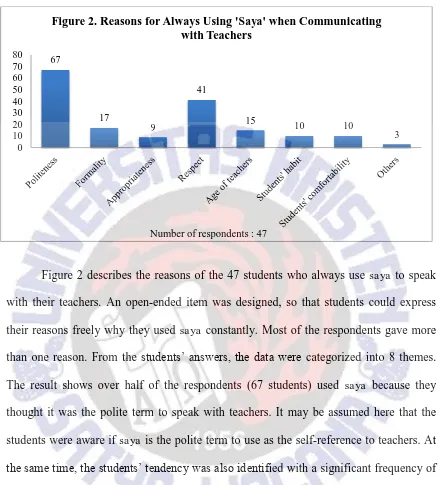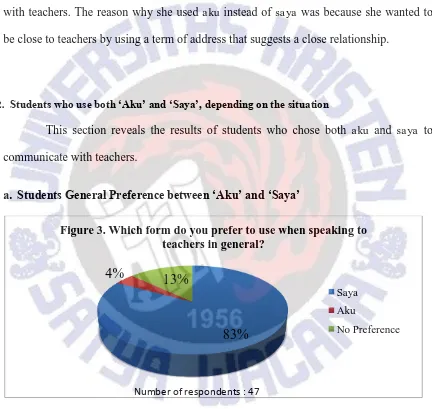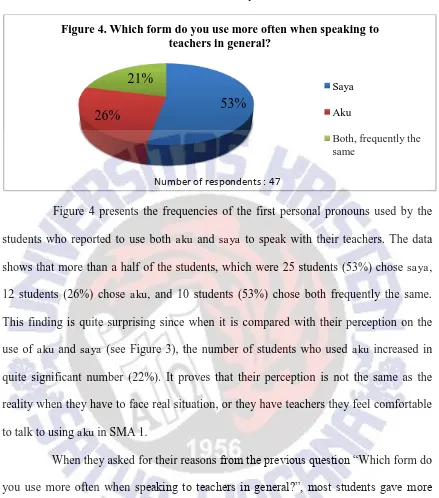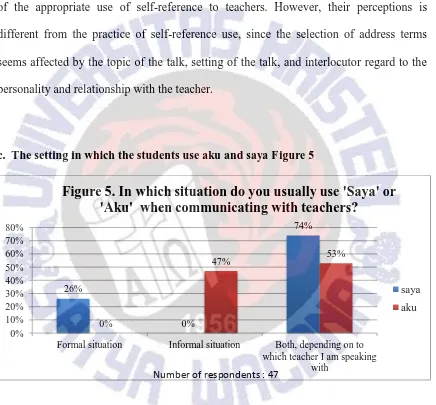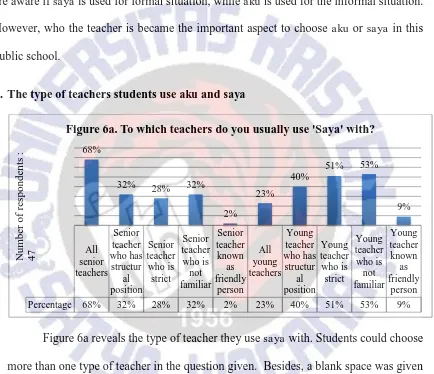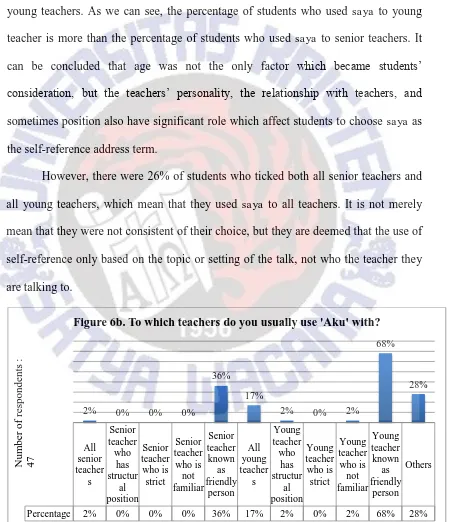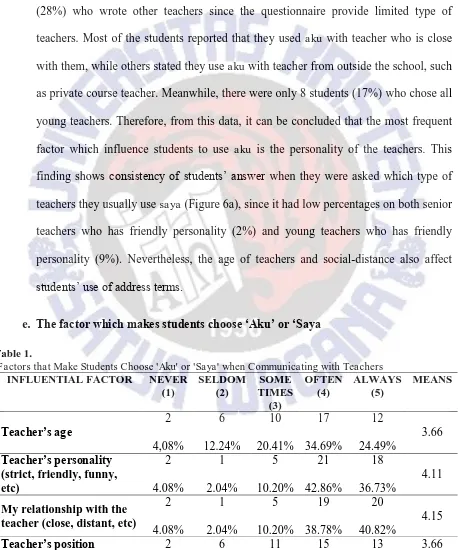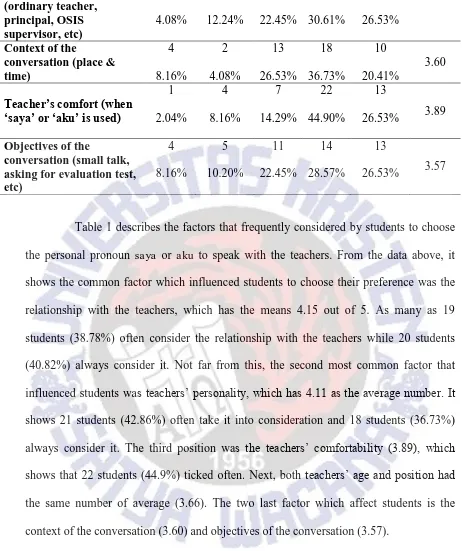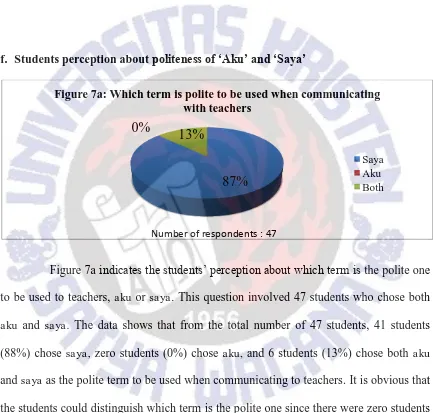i
Students’
Use of the Standard Variation of Indonesian Self-Reference
Addressing Terms of
Aku
and
Saya
toward Teachers
THESIS
Submitted in Partial Fulfillment of the Requirements for the Degree of
Sarjana Pendidikan
Rosyana Diva Lolyta
112013004
ENGLISH LANGUAGE EDUCATION PROGRAM
FACULTY OF LANGUAGE AND ARTS
UNIVERSITAS KRISTEN SATYA WACANA
ii
iii
iv
APPROVAL
FORM
Students’ Use of the Standard Variation of Indonesian Self
-Reference
Addressing Terms of
Aku
and
Saya
toward Teachers
THESIS
Submitted in Partial Fulfillment
of the Requirements for the Degree of Sarjana Pendidikan
Rosyana Diva Lolyta 112013004
Approved by:
Supervisor Examiner
v
COPYRIGHT STATEMENT
This thesis contains no such material as has been submitted for examination in any course or accepted for the fulfillment of any degree or diploma in any university. To the best of my knowledge and my belief, this contains no material previously published or written by any other person except where due reference is made in the text.
Copyright@ 2016. Rosyana Diva Lolyta and E. Titik Murtisari, S.Pd, M.TransStud, Ph.D
All rights reserved. No part of this thesis may be reproduced by any means without the permission of at least one of the copyright owners or the English Department, Faculty of Language and Literature, Universitas Kristen Satya Wacana, Salatiga.
vi
vii
TABLE OF
CONTENTS
COVER ... Error! Bookmark not defined.
PERNYATAAN TIDAK PLAGIAT ... ii
Code Selection and Term of Address in Communication ... 3
Term of Address in Indonesia ... 4
Code Selection of Address Term in Relation with Politeness Theory ... 5
Previous Studies ... 7
a. Students who use ‘Saya’ exclusively ... 14
b. Students who use ‘Aku’ exclusively ... 15
2. Students who use both ‘Aku’ and ‘Saya’, depending on the situation ... 15
a. Students General Preference between ‘Aku’ and ‘Saya’ ... 15
b. Students' General Use between 'Aku' and 'Saya' ... 17
c. The setting in which the students use aku and saya Figure 5 ... 18
d. The type of teachers students use aku and saya ... 19
e. The factor which makes students choose ‘Aku’ or ‘Saya ... 21
viii
II. Stimulated Response Card ... 25
CONCLUSION ... 29
ACKNOWLEDGEMENT ... 31
REFERENCES ... 32
1
Students’
Use of the Standard Variation of Indonesian Self-Reference
Addressing Terms of
Aku
and
Saya
toward Teachers
ABSTRACT
The Indonesian language has two standard variations of address terms to refer to oneself, which are aku and saya. Students are traditionally expected to use saya instead of aku to teachers because it is considered to be the more formal and polite form. However, the use of the personal pronouns seems to have been shifting in recent years. Therefore, this study aims to investigate high school students’ use of self-reference addressing terms aku and saya to teachers. Questionnaires were used to obtain the data from 127 participants of the second grade of Senior High School 1 Salatiga. To explore further information, stimulated response cards also were used to examine 10 students who chose both aku and saya. The general results demonstrate that the majority of the respondents still used saya exclusively, and only one student used aku. Nevertheless, there were also a significant number of students who used both aku and saya. The biggest factors that affect the term selection were the relationship with teachers and teachers’ personality.
Key words: self-reference, address terms, saya, aku, language shift, politeness
INTRODUCTION
In communicating with someone, there are many things that need to be considered by
a speaker, and one of them is the code selection of self-reference addressing terms. People
have many kinds of variations to address themselves depending on the formality, social
status, age difference, and relationship (Djenar, 2007). Meanwhile, Indonesian language has a
large range of self-reference which is different from English since it has “limited set of pronoun” (Flannery, 2009, p. 1) to say ‘I’. However, aku and saya are the only standard
variation of Indonesian self-reference, which can be found in the Indonesian Dictionary.
Nevertheless, these terms of variation are used differently depend on many factors including
their formality and politeness. According to some researchers, such as Djenar (2007), Dewi
(2009), Flannery (2010), and Yoong (2011), the term aku is considered as informal and often
2
both formal and informal pronoun to speak with a person who has higher status. With this in
mind, it can be concluded that the term saya is more polite than aku.
However, several studies haves indicated that nowadays some students seem to shift
the pronoun saya to aku in communicating with their teachers. Whereas, there should be
boundaries between students and teachers regarding their differences in terms of age, group,
and status (Dewi, 2009).
Moreover, politeness is also included in someone’s consideration to choose the term
of address when they speak. As Trans (2010) pointed out “politeness also impacts on the
choice between different address forms.” (p. 13). In addition, Yui (2012) stated that terms of
address is a tool to adjust the relationship between the speaker and the hearer, and they are
deeply related to politeness. Thus, the concern of this study will highlight the politeness as
one of the factors which affects students’ choice of address terms since the use of aku and
sayareflects people’s values, including of politeness.
Hence, if we take a look on the issue above, students are supposed to change the
language choice and apply saya instead of aku since it is suggested as a polite form to adress
themselves to teachers. Regarding this assumption, it is necessary to pay attention to the use
of personal pronoun choice by students in Indonesia.
Furthermore, the previous finding by Rahardjono (2016) focused on the use of
singular form self-reference in English Department of Satya Wacana Christian University
shows that the majority of students consistently use saya, and some of them use both aku and
saya depending on the situation. Although the previous study has found relatable result, it is
necessary to have further study under the same topic since it has limitations. Besides, the
researcher is interested in investigating the use of self-reference by the students in different
3
students use to speak with their teachers in Senior High School 1 Salatiga and also the
reasons behind their choice.
By conducting this study, the researcher wants to discover about the current trend in
the use of aku and saya by students to teachers, and map students’ use of aku and saya. By
doing so, these can inform language policy in Indonesia about the use of standard variation of
Indonesian personal pronouns. Moreover, this study might become an input for the future
language planning of Indonesian in term of self-reference addressing terms.
REVIEW OF LITERATURE
Code Selection and Term of Address in Communication
In communicating with someone, there are many factors as a speaker to consider.
According to Hymes (1972) in Johnstone and Marcellino (2010) there are eight factors
influencing people in speech that known as SPEAKING, which stands for:
(S) Setting including the time and place, physical aspects of the situation such as arrangement of furniture in the classroom; (P) participant identity including personal characteristics such as age and sex, social status, relationship with each other; (E) ends including the purpose of the event itself as well as the individual goals of the participants; (A) act, sequence or how speech acts are organized within a speech event and what topic/s are addressed; (K) key or the tone and manner in which something is said or written; (I) instrumentalities or the linguistic code i.e. language, dialect, variety and channel i.e. speech or writing; (N) norm or the standard socio-cultural rules of interaction and interpretation; and (G) genre or type of event such as lecture, poem, letter(p. 8).
Furthermore, Holmes (2013) believed that there are four main factors which affect a
person to talk, which are social distance scale (intimacy of participants), status scale (position
of participants), formality scale (setting or type of interaction), and functional scale (purposes
or topic of interaction).
In daily communication, addressing terms related to self reference is a crucial aspect
4
concerns a large number of researchers, especially whose area is sociolinguistics. As Afful
(2007, p. 179) pointed out, “address forms represent very fundamental means of forging human interaction, thus performing an interpersonal role”. Moreover, Parkinson (1985) in
Moghadam et al. (2013) proposed that “terms of address can function as a very important treasure trove of social information” (p. 56).
According to Oyetade (1995) in Afful (2007) address terms is “an expression used in
a face-to-face situation to designate an addressee” (p. 180). To Wardhaugh (2006), the use of
address terms can be used to indicate the extent of ‘a power differential’ between the speaker
and hearer. With all this in mind, it can be concluded that terms of address are forms to
address or refer to someone or something to indicate the differential of power and distance
between the addresser and addressee when they are communicating to each other.
Furthermore, the code selection use of self-reference or personal pronoun is very
substantial in daily communication between the speaker and the interlocutor. According to
Moghadam et al (2013) address terms are very important to show interpersonal relationships,
and become an indicatior of politeness in a society. While Djenar (2007) noted that they vary
depending on the formality, social status, age difference and relationship between the
addresser and addressee. Both of them state that the relationship of the speaker and
interlocutor(s) could become the main concern to someone to choose the term of address they
use while communicating with the interlocutor.
Term of Address in Indonesia
Different from English which has a finite pronoun to say ‘I’, Indonesian has a large
range of words to refer to oneself (Flannery, 2009). Therefore, there is possibility for
someone to choose several codes in terms of addressing themselves. Moreover, Court (1998)
5
‘open’ pronoun systems, where there are some alternative ways to say ‘I’ and ‘you’. This is
very contrast with the Europe language that has ‘closed’ pronoun system, which only has one
pronoun for person. Therefore, the people of Southeast Asian, especially Indonesian need to
make selection of address term whenever they communicate with someone.
This research focuses on self-references which are used in Indonesia. According to
Kamus Bahasa Indonesia (the Indonesian Dictionary) the term aku refers to the informal
variety to communicate with close friends or to a person with lower status, while saya can be
used for both formal and informal setting or to a person who have higher status. Besides, a
past study by Mintz (1994) in Djenar (2007) pointed that “Formality is suggested as corresponding to neutrality; and neutrality as corresponding to non offensiveness”. Moreover,
Morgan (2010) elaborated that “aku is generally considered more intimate, and is often used when speaking to children and between equals who have a close relationship” (p. 28), while
saya is the neutral version of ‘I’ and endorsed as the standard formal Indonesian pronoun.
(Sneddon, 1997; Quinn, 2001; Sneddon, 2003) in Morgan (2010).
Thus, from this opinion, it can be concluded that on the one hand, the pronoun saya is
considered as a neutral pronoun that can be used to speak with anybody in any situation,
which potentially cause less offensiveness. On the other hand, pronoun aku is considered as
informal and may be offensive when inappropriately used. For instance, to someone who
never met before, the use of aku may be very offensive.
Code Selection of Address Term in Relation with Politeness Theory
One of the most important aspects in communicating with someone is politeness. According to Tran (2010) “Politeness is one of the key factors in the value and, thereby, an
indispensable part of effective communication” (p. 12). He also added that a polite
conversation is considered by many factors of the interlocutor such as age, social position,
6
politeness can be seen in the form of address term choice. Similarly, as Holmes (1992) in
Tran (2010) pointed that in eastern Asian, the use of address term denotes the social status
which also emphasizes the age, positions, and social contexts.
Furthermore, politeness in the choice of address terms normally includes the
consideration of interlocutor feeling. As Holmes (1992) in Tran (2010) says that “the more
polite a person is the more comfortable others feel” (Tran, 2010, p. 17). This is also supported
by Brown & Levinson (1987) who claimed that it is important to make all the parties
comfortable with each other. In addition, the function of positive politeness is to make other
parties feel comfortable by showing respect to the hearer (Yui, 2012).
However, Brown & Levinson (1987) in Moghadam et al (2013) elaborated politeness
become positive politeness and negative politeness. Positive politeness is when the speakers
are intimate to each other whereas negative politeness is when the participants formal to each
others to show awareness of social distant which is frequently obtained through address
forms of honorifics and titles.
In educational context, the relationship between students and teachers is considered as
a formal relationship. Thus, in normal context the students are expected to use saya instead of
aku. In spite of this, the use of self reference seems to be shifting. As Holmes (2013) claimed
that language changes over time. In addition, he also mentioned that one of the factors
influencing the language change is the social factors, like who you are talking to, the social
context of the talk, the function and topic of the discussion. In this case, the language shift
occurrence contradicts with the theory of politeness between the students and teacher, where
there should be boundaries between them since there are differences in their age, group, and
7
the students realize that they are supposed to change the language choice and apply saya
instead of aku if they have a good manner and have much knowledge of politeness.
However, in recent study by Djenar (2007), the result showed that there has been a
significant increasing number of using pronoun aku by celebrities when they were
interviewed by the media television in several broadcast of infotainment or celebrity
news/gossip program. They did such things not to show their arrogance or offensive speech, but to create such a familiar atmosphere to the viewers. This change may also affect students’
code selecting pronoun saya to aku is the celebrity speech. By watching this thing, the shift
pronoun to aku may be applied by the student consciously or unconsciously in daily
communication, including with their teachers. Regarding this, it is necessary to pay attention
to the use of personal pronoun choice by students to their lecturer nowadays. As Tran (2010)
suggested that “students should be made aware of the different forms of address, which
consider the age, relationship and social status of the person they are talking to, since
people of different ages have several ways of expressing politeness” (p. 19). Furthermore, he
also mentioned that older people conversation tend to be more formal, polite, and use the
standard forms of address, while young people is more informal since they are more flexible
and have new ways in their talk to maintain politeness.
Previous Studies
A number of researchers have conducted studies to investigate address terms and code
selection. For instance, a study by Flannery (2009) pointed out the differences of Indonesian
and English self-references and addressee-references. He used Australian-English, and took
the Indonesian data from forty years of Kompas newspaper (1965 to 2005), a mainstream
Jakarta daily, and other official media channels, such as the government sanctioned news
8
single term to refer for both first and second person reference. While conversely, Indonesia
has multiple terms of first and second person reference.
A similar study was conducted by Djenar (2007). This research focused on self reference in Indonesia. The study entitled ‘Self Reference and its Variation in Indonesian’
aims to examine the self referring variation in Indonesia which focused on the pronoun aku,
saya, gue/gue, and proper names. She claimed that “there is no uniformity in the speakers’
choice of term. Some speakers consistently use one term, while others shift between two or
more terms within the same interview” (Djenar, 2007, p. 38). However, this study only
concentrated on celebrity pronoun choice on the media television. Thus, what makes the
writer wants to find out the use of self pronoun in the educational context, especially from the
students to their teacher.
Another study, which was conducted by Dewi (2008), investigated the shift in the use
of aku and saya among children and teenagers from the students and teachers’ perception.
The data were taken in elementary and junior high school in Jakarta. Generally, students
participants are sure know the difference concept of the use aku and saya since they believe
that their parents already taught them how to use it appropriately. However, the students
agree that the television influence them, so that the practice shows lower percentage than
those who know it. In addition, the teachers who think the students are influenced by the media television are higher than the students’ perception. Although the percentages of
students’ and teachers’ perception about the use of aku and saya showed different number, it
was not significant. Overall, this quantitative study revealed that there is twenty percent shift
of the students self reference choice from saya to aku while speaking to their teacher.
Moreover, a recent study entitled ‘Students’ Attitude in Using First-Person Reference
Addressing Terms of Aku and Saya To Teachers’ has been conducted by Rahardjono (2016)
9
students to their lecturer in English Department of Satya Wacana Christian University. This
qualitative study showed that the 62% of the students consistently use saya and 38% of them
use both aku and saya depending on the setting. The participants tended to use aku in
informal context because it sounds friendlier. Thus, clearly expose that the shift of saya to
aku happened in the educational context. Hence, the possibility of the students use saya may
have the same number as the possibility of the use aku in referring self reference to their
teachers.
Therefore, though the previous study has found such a relatable result, it is necessary
to have further study under the same topic for it have not specifically addressed the concern
and only analyzed it on the surface. Moreover, the researcher is interested to learn about specific concern like politeness which is related to the students’ use of the standard variation
of Indonesian self-reference.
THE STUDY Research Questions
The following research questions have been made to complete the objective of this
study:
1. What personal pronoun do the students use to refer to themselves when
communicating with their teachers?
2. What are the factors that affect students in choosing self-reference Aku and Saya
10 Context of the Study
This present study is part of an umbrella research project entitled ”High School Students’ Use of Saya and Aku in Salatiga” led by Dr. E.T. Murtisari (Faculty of Language
and Arts, Universitas Kristen Satya Wacana).This qualitative study was taken in one of
public Senior High School which is located in Salatiga, Central Java, Indonesia. Specifically,
the study was conducted in Senior High School 1 Salatiga. The writer chose this place since it
is one of favorite high schools in the town which is assumed that it has well-mannered
students. Moreover, this school has been chosen due to researcher’s convenience and
familiarity.
Participants
The subjects of this study were 127 students who are in the second grade of senior
high school. Senior high school students have been chosen since it is assumed that they have
more experience in communicating with their teachers and more understand how to apply the
self-reference appropriately. Moreover, the writer chose second grade students since they are
suitable to represent senior high school students who are not in the transition period like first
grade or third grade students.
Methodology
The researcher used qualitative method to conduct this study. ‘Qualitative descriptive study is the method of choice when straight descriptions of phenomena are desired’
(Sandewolski, 2000, p. 334). The writer wanted to describe and analyze about the students’
preference of using Indonesian self-reference aku and saya while speaking to their teachers.
Moreover, the participants were divided with the criteria as follows: (a) students who
tend to use aku exclusively when communicating with teachers, (b) students who tend to use
11
aku and saya when communicating with teachers. To obtain the data, the writer used a
questionnaire adapted from Rahardjono (2016) by the umbrella research team and supported
by Stimulated Response Cards also developed by the team with 10 selected participants to
enrich the data and investigate deeper information.
Data Collection
There were some procedures the researcher had done to collect the data, which were:
1. Piloting the questionnaire to 5 participants and the stimulated response card to 3
participants to know the validity and reliability of the instrument.
2. Making appointment with teachers who taught the second grade students to spread the
questionnaires in the classrooms.
3. Spreading the questionnaire to the students on the second grade of Senior High School 1
Salatiga.
4. Analyzing the data using Excel.
5. Selecting 10 students who chose both saya and aku to be interviewed using stimulated
response cards.
Furthermore, below were the steps of using the stimulated response cards done by the
researcher:
1. Asking 10 students to go out of their classrooms to play stimulated response cards and do
interview.
2. Asking each student to answer all of the situations and conditions from the cards one by
one.
12
4. Investigating each of the students by asking follow-up questions to constrict the factors
of their selections.
Data Analysis
After the data were collected, the researcher used a categorical or thematic analysis and took the themes from the participants’ answers from the questionnaire. Afterwards, the
researcher compiled the data and classified them according to the themes and then analyzed it
qualitatively. The result of this study would be used to describe the students’ use of
Indonesian self-reference aku and saya with their teachers in Senior High School 1 Salatiga
Research Instrument
To collect the data from the participants, the researcher used questionnaire (Appendix
1) which was adapted from Rahardjono (2016) by this study’s umbrella research team as the
instrument. In each questionnaire, there are 4 parts of questions. On the first part, there was
one closed-ended question to determine students’ preference of self-reference. On the second
part, there was an open-ended question to answer the reason why they consistently use saya.
On the third part, there was also an open-ended question for the students who use aku
exclusively. The fourth part was designed for those who used inconsistent term of
self-reference depending on the situation. There were seven items of close-ended questions, three
items of open-ended questions to explain their answer related to their choice, and seven questions of likert scale to find out the factors affect the students’ choice. The selected
students later had been investigated using stimulated response cards (Appendix 2) to get
further information about the factors influence their choice based on Hymes (1972) and
Holmes (2013). In the stimulated response cards, there were six factors needed to be
considered by the students when answering each of the card, which were: age of teachers
13
teachers (distant vs close); topic of the talk (ask about the lesson vs small talk); personality of
teachers (friendly vs strict); and the setting of the talk (classroom vs canteen).
FINDINGS AND DISCUSSIONS I. Questionnaire
This section will discuss the findings which were obtained from the questionnaire
answered by the students.
1. Students’ selection of using ‘Saya’ or ‘Aku’
Figure 1 represents the students’ choice of address terms saya, aku, or both when
they spoke with teachers. From the total number of 127 respondents, the majority of the
students, which were 79 respondents (62%) chose saya to speak with their teachers, while
only 1 respondents (1%) chose aku. However, as many as 47 respondents (37%) chose
both saya and aku under the consideration of the situation they faced when they were
communicating with teachers. This finding is very interesting since there was a significant
number of the students who used both saya and aku, while they were expected to use saya
only to speak with teachers.
62%
1%
37%
Figure 1. When you are speaking to teachers, how do you call yourself in front of them?
Saya Aku
14 a. Students who use ‘Saya’ exclusively
Figure 2 describes the reasons of the 47 students who always use saya to speak
with their teachers. An open-ended item was designed, so that students could express
their reasons freely why they used saya constantly. Most of the respondents gave more
than one reason. From the students’ answers, the data were categorized into 8 themes.
The result shows over half of the respondents (67 students) used saya because they
thought it was the polite term to speak with teachers. It may be assumed here that the
students were aware if saya is the polite term to use as the self-reference to teachers. At the same time, the students’ tendency was also identified with a significant frequency of
respect theme (41 students). It means the students really honor the teachers in their
school since they also stated that teacher is the person who has taught them many things,
so they need to be respected. Furthermore, some of them also related the age factor with
respect and appropriateness. They said that if they spoke to older people, they had to be
respectful and used appropriate language. These can be seen in students’ answer, which
mentioned the age of teachers (15 students) and the appropriateness of language by 9
Figure 2. Reasons for Always Using 'Saya' when Communicating with Teachers
15
that had written by students, which are not less important were formality; habit; students’
comfortability; and other factor which were not in the aforementioned category, such as
the social distance with teachers, maintain his self-image in front of teachers.
b. Students who use ‘Aku’ exclusively
There was only one student who chose aku to address herself when speaking
with teachers. The reason why she used aku instead of saya was because she wanted to
be close to teachers by using a term of address that suggests a close relationship.
2. Students who use both ‘Aku’ and ‘Saya’, depending on the situation
This section reveals the results of students who chose both aku and saya to
communicate with teachers.
a. Students General Preference between ‘Aku’ and ‘Saya’
Figure 3 shows sudents who chose both aku and saya preference when
speaking to teachers in general. From the total number of 47 respondents, 39 students
(83%) chose saya while only 2 students (4%) reported to choose aku, while 6 students
(13%) had no preference. This demonstrates that even though they chose both aku and
saya, the majority of the students still preferred pronoun saya to speak with teachers.
83%
4%
13%
Figure 3. Which form do you prefer to use when speaking to teachers in general?
Saya Aku
No Preference
16
This finding correlated with Indonesian culture which value saya as appropriate address
term to speak with teachers.
When asked for their reasons for their preference, they gave more than one
answer. Most of the respondents who chose saya to speak with teachers stated that it was
because saya is the polite term to use to teacher (34 students). Other reasons that had
written by students were because: they have to respect the teachers; saya is used to speak
with older people; and saya is more formal. Again, politeness became the most frequent
reason why the students chose saya. On the other hand, the students who chose aku
reported that they often use it when speaking to the teachers whom they familiar with.
This finding reflects the views of Holmes (1972) in Tran (2010), Yui (2012) and Djenar
(2007) which stated that relationship or social-distance become the prominent factor
influence the speaker to use the variation of language to communicate with someone.
Meanwhile, students who chose no preference explained that it depends on
who the person is he/she speaking with, the age of teachers, and the formality (situation
and topic of the talk). Thus, the students might think since the meaning of both address
terms is the same, so they would refer to what situation or who the teacher they were
17
b. Students' General Use between 'Aku' and 'Saya'
Figure 4 presents the frequencies of the first personal pronouns used by the students who reported to use both aku and saya to speak with their teachers. The data
shows that more than a half of the students, which were 25 students (53%) chose saya,
12 students (26%) chose aku, and 10 students (53%) chose both frequently the same.
This finding is quite surprising since when it is compared with their perception on the
use of aku and saya (see Figure 3), the number of students who used aku increased in
quite significant number (22%). It proves that their perception is not the same as the
reality when they have to face real situation, or they have teachers they feel comfortable
to talk to using aku in SMA 1.
When they asked for their reasons from the previous question “Which form do
you use more often when speaking to teachers in general?”, most students gave more
than one answer. This question was created in an open-ended question. For students who
chose saya, they reported that the reason is because (1) it was a habit, (2) saya is the
polite term to use to teachers, (3) they have to respect teachers, (4) saya is used to speak
with old people.
Meanwhile, the students who chose aku claimed that it because they are
comfortable to use aku and it was a habit. This is because perhaps they have some
53%
26%
21%
Figure 4. Which form do you use more often when speaking to teachers in general?
Saya Aku
Both, frequently the same
18
teachers who they feel comfortable to speak aku and it became their habit to do so.
Besides, the situation and who the teacher is became the most frequent reasons for the
students who chose ‘both frequently the same’. That is why they have same frequency in
using both of the pronouns.
From the results above, we can conclude that the students are probably aware
of the appropriate use of self-reference to teachers. However, their perceptions is
different from the practice of self-reference use, since the selection of address terms
seems affected by the topic of the talk, setting of the talk, and interlocutor regard to the
personality and relationship with the teacher.
c. The setting in which the students use aku and saya Figure 5
This figure demonstrates the setting in which the students who chose both aku
and saya used when they communicating with teachers. There were two items given to
students to obtain this data. The first one is “In which situation do you usually use saya when communicating with teachers?”, and the second one is “In which situation do you
usually use aku when communicating with teacher?”. As indicated in figure 5, 12
Formal situation Informal situation Both, depending on to which teacher I am speaking
with
Figure 5. In which situation do you usually use 'Saya' or
'Aku' when communicating with teachers?
saya aku
19
students chose saya in informal situation. While 35 students (74%) only considered who
the teacher they talked with, and not pay much attention to the setting. On the other hand,
22 students (47%) used aku only in the informal situation, and none of them used it in
formal situation. In addition, 25 students (53%) used aku depending on the teacher they
speak with. From this result, this seems to show that all the students in this public school
are aware if saya is used for formal situation, while aku is used for the informal situation.
However, who the teacher is became the important aspect to choose aku or saya in this
public school.
d. The type of teachers students use aku and saya
Figure 6a reveals the type of teacher they use saya with. Students could choose
more than one type of teacher in the question given. Besides, a blank space was given
in case students had other types of teacher which were not mentioned in the
questionnaire. According to the data above, most of students ticked all senior teachers
(68%). Next, both senior teacher who have structural position and who are not
familiar have the same percentage (32%). Another senior teacher who was chosen by
students to use saya with was senior teachers who are strict (28%). However, only 1
student (2%) used saya to senior teacher who was known as friendly person. All Figure 6a. To which teachers do you usually use 'Saya' with?
20
Moreover, the data also indicates that the students used saya to young
teachers. It shows as many as 25 students (53%) used saya to young teacher who is
not familiar, and 24 students (51%) used it to young teacher who has strict
personality. Moreover, there were 19 students (40%) who chose young teacher who
has structural position. However, there were 11 students (23%) who used saya to all
young teachers. As we can see, the percentage of students who used saya to young
teacher is more than the percentage of students who used saya to senior teachers. It
can be concluded that age was not the only factor which became students’ consideration, but the teachers’ personality, the relationship with teachers, and
sometimes position also have significant role which affect students to choose saya as
the self-reference address term.
However, there were 26% of students who ticked both all senior teachers and
all young teachers, which mean that they used saya to all teachers. It is not merely
mean that they were not consistent of their choice, but they are deemed that the use of
self-reference only based on the topic or setting of the talk, not who the teacher they
are talking to. Figure 6b. To which teachers do you usually use 'Aku' with?
21
Further, the students were asked about the type of teachers they usually use
aku with. The finding clearly implies that the tendency of students in SMA 1 use aku
to teacher who has friendly personality. This can be seen from figure 6b that most
students ticked young teachers known as friendly person (68%) and senior teacher
known as friendly person (36%) to use aku with. Furthermore, there were 13 students
(28%) who wrote other teachers since the questionnaire provide limited type of
teachers. Most of the students reported that they used aku with teacher who is close
with them, while others stated they use aku with teacher from outside the school, such
as private course teacher. Meanwhile, there were only 8 students (17%) who chose all
young teachers. Therefore, from this data, it can be concluded that the most frequent
factor which influence students to use aku is the personality of the teachers. This
finding shows consistency of students’ answer when they were asked which type of
teachers they usually use saya (Figure 6a), since it had low percentages on both senior
teachers who has friendly personality (2%) and young teachers who has friendly
personality (9%). Nevertheless, the age of teachers and social-distance also affect students’ use of address terms.
e. The factor which makes students choose ‘Aku’ or ‘Saya
Table 1.
Factors that Make Students Choose 'Aku' or 'Saya'when Communicating withTeachers
22
Table 1 describes the factors that frequently considered by students to choose
the personal pronoun saya or aku to speak with the teachers. From the data above, it
shows the common factor which influenced students to choose their preference was the
relationship with the teachers, which has the means 4.15 out of 5. As many as 19
students (38.78%) often consider the relationship with the teachers while 20 students
(40.82%) always consider it. Not far from this, the second most common factor that
influenced students was teachers’ personality, which has 4.11 as the average number. It
shows 21 students (42.86%) often take it into consideration and 18 students (36.73%)
always consider it. The third position was the teachers’ comfortability (3.89), which
shows that 22 students (44.9%) ticked often. Next, both teachers’ age and position had
the same number of average (3.66). The two last factor which affect students is the
context of the conversation (3.60) and objectives of the conversation (3.57).
From the table above, it can be concluded that the factors affecting students in
choosing aku or saya was who the teacher is, especially the relationship with the teacher
and the personality of the teacher. The students did not really pay attention to where and
23
finding that the most of students ticked “never” on objectives of the conversation
(8.16%) and context of the conversation (8.16%).
However, this finding is really correlative with the previous finding, which
explicitly explained that the tendency of students’ choice depends on whom the teacher
they speak with (see Figure 5).
f. Students perception about politeness of ‘Aku’ and ‘Saya’
Figure 7a indicates the students’ perception about which term is the polite one
to be used to teachers, aku or saya. This question involved 47 students who chose both
aku and saya. The data shows that from the total number of 47 students, 41 students
(88%) chose saya, zero students (0%) chose aku, and 6 students (13%) chose both aku
and saya as the polite term to be used when communicating to teachers. It is obvious that
the students could distinguish which term is the polite one since there were zero students
who chose aku. This finding correlated with the previous finding when they were asked
for their reason to choose saya for their general preference (see figure 3) and general use
(see figure 4) since the most frequent reason appeared was politeness.
87%
0%
13%
Figure 7a: Which term is polite to be used when communicating with teachers
Saya Aku Both
24
The reason why students chose their preference of which term is the polite
term can be seen in Figure 7b. The result shows that 23 students said that because it is
indeed the polite term. Moreover, 16 students considered about the formality. Some of
them explained that it is because they usually speak with teachers in the school and in the
formal situation. As many as 13 students reported that it was because they have to
respect the teachers, hence saya is the polite term to use. This finding correlated with Yui
(2012) who claimed that respect the hearer is one of the functions of politeness. Other 5 students’ answers were equivalent with Holmes (1972) as cited in Tran (2010) who
pointed that age is also the factor of politeness. However, there were 4 students whose
answers were categorized in appropriateness and said that saya is the good and correct
terms whatever and whenever the situation is. In addition, they reported that it is
offensive to say aku with teachers. Meanwhile, students whose answer categorized to
others informed that it is because they were comfortable to use that, and it showed that
the teachers have higher status than them. However, for students who chose both aku and
saya reported that it all depends on the situation, the personality of teachers, and the
Politeness Formality Appropriateness Respect the teachers
Age of teachers Others Figure 7b: Students Reasons to which term is polite to be used
with teachers
25
This finding shows students’ consistency in choosing their preference which is
correlated with most of the previous figures since it represents that the biggest number of students’ reason for choosing their preference was because of the politeness. Therefore,
most of the students in SMA 1 seems really understand that saya is the polite and
appropriate term to be used toward teachers.
II.Stimulated Response Card
This section will discuss the findings which were obtained from the stimulated
response cards answered by the students. To obtain the data, 10 students who chose both
aku and saya were selected. Then, the students were asked to answer all of the 16
stimulated response cards one-by-one randomly, which had different situations and
conditions on each of the card. Afterwards, students were investigated by follow up
questions to gain deeper information.
In general, all of the ten students were consistent using both of the address
terms to speak with teachers. Figure 8a represents the factors which made students used
saya with the teachers. The most common factors affecting the students’ choice of saya
were the distant relationship with teacher (18%) and teacher’s strict personality (18%) 16%
16% 18% 16%
18%
16%
Figure 8a. Factors affecting students' in choosing 'Saya' to teachers
Teeacher's senior age Teacher's position as a principal Student-Teacher Distant Relationship Lesson Topic
Teacher's Strict Personality Formal Setting (Classroom)
26
since these two factors were presented in parallel form on the stimulated response card.
The other factors did not have significant differences, and have the same percentage on
each factor (16%).
Table 2. Students’ choice of ‘aku’ and ‘saya’ from stimulated response cards
27
S14
(Factors: senior teacher, lesson topic, in classroom)
Saya Saya Aku Aku Aku Saya Aku Saya Saya Saya
S15
(Factors: senior teacher, distant relationship strict
teacher)
Saya Saya Saya Saya Saya Saya Saya Saya Saya Saya
S16
(Factors: senior teacher) Aku Saya Aku Aku Aku Saya Aku Saya Saya Saya
Total use of Saya 10 14 5 6 12 13 9 15 14 15 Total use of Aku 6 2 11 10 4 3 6 1 2 1
Furthermore, there were some conditions when students were expected to use
saya, such as when they have to speak with senior teacher; principal; strict teacher;
teacher who have distant relationship with the student; when they talked about serious
topic (lesson); and when they were in formal setting (classroom). Thus, these factors were categorized as the positive factors which determine students’ use of saya. On the
other hand, there were also some factors that made students did not use saya, such as
when they talked to young teacher; an ordinary teacher; teacher who had
close-relationship with student; friendly teacher; when they had small talk; and they were in
informal setting (canteen). These factors were categorized as the negative factors which
determine students’ use of saya. The researcher tried to mix-match the positive and the
negative factors to use saya in the stimulated response cards and see which one the factor
that influence students most.
Table 2 describes students’ choice of aku and saya when they had to face
different factors. Overall, the use of saya and aku by students who participated in
answering the stimulated response cards has a fairly big range (saya:aku=71%:29%).
This might indicate that most of the students still follow the prescribed rules and
28
As seen in Table 4, when they had to face all of the positive factors to use saya
(S1), all of students indeed used saya. In contrast, when they faced all of the negative
factors to use saya (S12), none of the students used saya. These mean that students may
had good knowledge about the prescribed rules of Indonesian personal pronoun and
follow it according to the context. When they were investigated, the most factors that influenced students were the relationship with teacher and teacher’s personality. This
correlated with students’ answer on some of the cards which contained teacher’s distant
-relationship with students and teacher who had strict personality (S3, S5, S7, S9, S13,
and S15) since most of the students chose saya.
The next factor which influences students most was the age of teacher. As
written on some cards which contain senior teacher (S1, S2, S3, S13, S14, S15), most of
students chose saya, except in the case of situation 4 and 16. Though on these two
stimulated response cards also contain senior teacher, half of the students chose aku. It
was probably because it described the close relationship with teachers and teacher’s who
had friendly personality. Other factors like the structural position of teachers, setting of
the talk, and topic of the talk was not concerned much by the students.
These findings correlated with previous finding (Table 1), which shows that
the tendency of students in SMA 1 to choose the address term of self-reference depends
on who the teacher is, especially the relationship and personality of the teachers. It may
imply that most of the students were consistent about their reason(s) in choosing the
self-reference to speak with teachers.
Further, another factor that affected students was Javanese influence (1%).
One student which comes from suburban area said that he would use kulo to senior
29
same meaning as saya. It was because he always uses Javanese in his home and in his
previous school. This finding was correlated with Holmes (2013) who asserted that
ethnicity is also included in the social factors when people communicate to each others,
such as addressing or greeting someone.
CONCLUSION
As mentioned earlier, the choice of personal pronoun has an important role when
communicating with someone. Thus, nowadays, it is assumed that there has been a language
shift from saya to aku on young generation when they speak to teachers, which is considered
impolite since there are many gaps between them, such as age; social-distance; social-status;
etc. Therefore, this study has been undertaken to investigate students’ use of standard
variations of Indonesian self-reference aku and saya toward teachers and the reasons behind
their preference.
Based on the finding of the current study, the majority of the students used saya
(62%), only (1%) of the students used aku, and there are (37%) students used both aku and
saya, depending on the situation. In general, the reason of the students who chose saya was
because it is an appropriate and polite term to use to teachers. However, the students who
used both aku and saya tend to consider the relationship with the teacher and the personality
of the teacher. In conclusion, there is indeed a shift from saya to aku by students to teacher,
but not in a great number since the students still aware of the gaps between them and know
when and where to use them.
Furthermore, the researcher hopes that this finding could give information about the
recent use of aku and saya in educational setting by students to teachers, especially in public
school. For students, it is necessary to pay attention to self-reference when they have
30
suggested to highlight politeness and accustom students to use the polite form when speaking
with them to build good personality of students, especially in educational setting.
However, there are some limitations which are able to be improved for the future
study. Firstly, the stimulated response cards to obtain the data could be developed more by
adding, combining, and mix-matching the factors affecting the students to use saya or aku to explore students’ choice since there are more chances which might be faced. Secondly, this
study was very contextual, so that it cannot be generalized into the wider context. Therefore,
it is suggested to have more research in a larger scope of participants for further investigation,
such as in all public schools in Salatiga. Besides, more studies are also necessary to see to
31
ACKNOWLEDGEMENT
First of all, I would like to give my greatest gratitude to the almighty and the merciful
Allah SWT for giving me abundant blessing and grace that always strengthen my mind and
my spirit so that I had chance to learn a lot of things and finish this thesis. Moreover, this
thesis cannot be done without the support of many special people around me. Therefore, my
special thanks are addressed to my family, especially my mother and father for their limitless
prayers and for supporting me throughout this past couple of month of thesis.
Next, I would also like to express my sincere gratitude to my thesis supervisor Ibu E.
Titik Murtisari, S.Pd, M.TransStud, Ph.D and my thesis examiner Bapak Joseph Ernest
Mambu, Ph.D. for the guidance and willingness to give inputs, comments, and suggestions
which had helped me a lot throughout my thesis completion. I would also like to thank all of
ED Lecturers and staff who helped me a lot, especially my advisor Bapak Dian Toar Y. G.
Sumakul, S.Pd, M.A for enlightening directions during 4 years of study.
I would also like to thank my beloved friends Desy Rizki Lukitasari and Dea Devina
Fabrian for their assistance during my data collection and for their happiness shared with me.
Another special thank goes to Ralinga Arjuna Cindra for becoming the best partner all this
time. Thank you for your patience to always understand and listen to my complaints. Last but
not least, I thank my fellow Thirteeners for the togetherness and memorable experiences
during these years. Once again, thank you for everyone who has not been mentioned who has
32
REFERENCES
Aeni, E. S., W., & Ratnasari, D. (2014). Synonymy Enrichment in Language Editing. The International Journal of Language Learning and Applied Linguistics World (IJLLALW),5(3)., 7-14.
Afful, J.B.A. (2007). Address forms and variation among university students in Ghana. Nordic Journal of African Studies, 16(2): 179–196. University of the Witwatersrand, South Africa. Retrieved on October 2nd, 2016fromwww.njas.helsinki.fi/pdf-files/vol16num2/afful.pdf
Cajnko, M. (2016). Politeness in Hittite state correspondence: Address and self-presentation. Journal of Politeness Research,12(2). doi:10.1515/pr-2016-0006 Dewi, I. (2009). “Sayamau, Bu!” or “Akumau, Bu!”? from the teachers and students’ point of
view. Jurnal Lingua Cultura, 3(1), 1-10.
Djenar, D. N. (2006). Patterns and Variation of address terms in Colloquial Indonesian. Australian Review of Applied Linguistics Address from a World Perspective,29(2). doi:10.2104/aral0622 Communication. The SAGE Handbook of Sociolinguistics, 57-66. doi:10.4135/9781446200957.n5
Kameli, S., Mostapha, G. B., & Baki, R. B. (2012). The Influence of Formal Language Learning Environment on Vocabulary Learning Strategies. Journal of Language Teaching and Research,3(1). doi:10.4304/jltr.3.1.23-29
Moghaddam, A. S., Yazdanpanah, L., and Abolhassanizadeh, V. (2013). The analysis of Persian address terms based on the theory of politeness. SKASE Journal of Theoretical Linguistics [online], 10(3): 55-71. The Ohio State University.
Retrieved on November 10th, 2016 from
33
Morgan, A.M. (2009, July). Me myself and I: Exploring conceptions of self and others in Indonesian names and pronouns with early learners. Paper presented at the 17th Biennial Conference of Australian Federation of Modern Language Teachers Associations, Sydney, Australia.
Morin, I. (2005). Translating Pronouns, Proper Names and Kinship Terms From Indonesian Into English And Vice Versa. Teflin Journal, 16(2) . 181-194. Retrieved at
Rahardjono, V. (2016). Students’ Attitude in Using First-Person Reference Addressing Terms Of Aku and Saya To Teachers (Unpublished thesis). Satya Wacana Christian University.
Sandelowski, M. (2000). Whatever happened to qualitative description? Research in Nursing & Health,23(4), 334-340. doi:10.1002/1098-240x(200008)23:43.0.co;2-g
Saragih, C.F.(2012).The practical use of person reference in Papuan Malay.(Doctoral thesis), University Nijmegen, Holland. Retrieved on October 11th, 2016 from Doob&MaziarToosarvandani (eds.), Twenty-Seventh Meeting of the Berkeley Linguistics Society, 301-315. Berkeley: University of California at Berkeley, Department of Linguistics. Retrieved on October2th, 2016 from linguistics.berkeley.edu/~mhouser/houser_cv.pdf
Tran, V. M. Y. (2010). Vietnamese expression of politeness. Griffith Working Papers in Pragmatics and Intercultural Communication 3, 1 (2010), 12-21
34 APPENDIX
Appendix 1
KUESIONER
Penggunaan Kata “Saya” atau “Aku” oleh Siswa/i SMA Negeri 1 Salatiga
Saya, Rosyana Diva Lolyta, mahasiswi angkatan 2013 jurusan Pendidikan Bahasa Inggris (PBI) UKSW Salatiga. Saya membuat kuesioner ini untuk mengetahui sikap siswa-siswi SMA Negeri 1 Salatiga dalam memilih kata sapaan Aku atau Saya ketika berkomunikasi dengan guru. Saya akan sangat menghargai partisipasi Anda jika bersedia menjawab pertanyaan-pertanyaan dalam kuesioner ini. Jawablah dengan sejujur-jujurnya karena tidak akan mempengaruhi nilai pelajaran Anda. Tidak ada jawaban benar atau salah. Terima kasih banyak atas partisipasi Anda.
Silakan beri tanda centang (√) pada jawaban yang Anda pilih.
BAGIAN A
1. Ketika Anda berbicara dengan guru, bagaimana Anda menyebut diri Anda di depan mereka? Apakah Anda menggunakan ‘saya’ atau ‘aku’?
(a) ____ Saya (b) ____ Aku
(c) ____ Keduanya, tergantung situasi
Jika Anda memilih opsi (a) Saya, silakan langsung menjawab BAGIAN B. Jika Anda memilih opsi (b) Aku, silakan langsung menjawab BAGIAN C.
Jika Anda memilih opsi (c) Keduanya, tegantung situasi, silakan langsung menjawab
35
BAGIAN B (Jika Anda selalu menggunakan ‘saya’)
1. Apakah alasan Anda selalu menggunakan ‘saya’ ketika berkomunikasi dengan guru? Jelaskan.
BAGIAN C (Jika Anda selalu menggunakan ‘aku’)
1. Apakah alasan Anda selalu menggunakan ‘aku’ ketika berkomunikasi dengan guru? Jelaskan.
BAGIAN D (Hanya jika Anda menggunakan ‘aku’ dan ‘saya’ kepada guru)
1. Secara umum, mana yang lebih Anda suka untuk digunakan ketika berkomunikasi dengan guru?
(a) ____ Saya (b) ____ Aku
(c) ____ Tidak ada yang lebih saya suka
36
2. Secara umum, mana yang lebih sering Anda gunakan di antara ‘aku’ dan ‘saya’? (a) ____ Saya
(b) ____ Aku
(c) ____ Sama seringnya
Alasan:
3. Dalam situasi seperti apa Anda biasa menggunakan ‘saya’ ketika berkomunikasi dengan guru? (Pilih salah satu jawaban)
(a) ____ Situasi formal (contoh: di dalam kelas, saat mengerjakan tugas, dll.)
(b) ____ Situasi tidak formal (contoh: berbicara dengan guru saat bertemu di kantin atau tempat lain di luar jam sekolah)
(c) ____ Keduanya, tergantung kepada guru yang berbicara dengan saya
4. Kepada guru yang seperti apa Anda biasa (sering) menggunakan ‘saya’? (Anda bisa memilih lebih dari satu jawaban)
(a) ____ Guru senior yang punya jabatan struktural (contoh: kepala sekolah, wakil kepala sekolah, dll.)
(b) ____ Guru senior yang terkenal tegas
(c) ____ Guru senior yang saya tidak terlalu kenal (d) ____ Guru senior yang terkenal ramah
(e) ____ Semua guru senior
(f) ____ Guru muda yang punya jabatan struktural (contoh: kepala sekolah, wakil kepala sekolah, dll.)
37 (h) ____ Guru muda yang saya tidak terlalu kenal (i) ____ Guru muda yang terkenal ramah
(j) ____ Semua guru muda (k) Lainnya (sebutkan):
5. Dalam situasi seperti apa Anda biasa menggunakan ‘aku’ ketika berkomunikasi dengan guru? (Pilih salah satu jawaban)
(a) ____ Situasi formal (contoh: di dalam kelas, saat mengerjakan tugas, dll.)
(b) ____ Situasi tidak formal (contoh: berbicara dengan guru saat bertemu di kantin atau tempat lain di luar jam sekolah)
(c) ____ Keduanya, tergantung kepada guru yang berbicara dengan saya
6. Kepada guru yang seperti apa Anda biasa (sering) menggunakan ‘aku’? (Anda bisa memilih lebih dari satu jawaban)
(a) ____ Guru senior yang punya jabatan struktural (contoh: kepala sekolah, wakil kepala sekolah, dll.)
(b) ____ Guru senior yang terkenal tegas
(c) ____ Guru senior yang saya tidak terlalu kenal (d) ____ Guru senior yang terkenal ramah
(e) ____ Semua guru senior
(f) ____ Guru muda yang punya jabatan struktural (contoh: kepala sekolah, wakil kepala sekolah, dll.)
(g) ____ Guru muda yang terkenal tegas
(h) ____ Guru muda yang saya tidak terlalu kenal (i) ____ Guru muda yang terkenal ramah
38
7. Hal-hal apa yang Anda pertimbangkan ketika memilih ‘saya’ atau ‘aku’ ketika berkomunikasi dengan guru? (Centang jawaban yang Anda pilih)
8. Mana yang menurut Anda sopan untuk digunakan ketika berkomunikasi dengan guru? (Pilih salah satu jawaban)
(a) ____ Aku (b) ____ Saya (c) ____ Keduanya
Jelaskan pilihan Anda.
No. Faktor yang
mempengaruhi
Tidak
pernah Jarang
Kadang-kadang Sering Selalu
1 Usia guru saya
2 Kepribadian guru saya (tegas, ramah, lucu, dll.)
3 Hubungan saya dengan guru saya (akrab, renggang, dll.)
4
Jabatan guru saya (guru biasa, kepala sekolah, guru kesiswaan, dll.)
5 Konteks percakapan (tempat dan waktu)
6 Kenyamanan guru (saat ‘saya’ atau ‘aku’ digunakan)
7
39 Data Diri Responden
Umur:
Jenis kelamin: Laki-laki / Perempuan (lingkari salah satu)
Kota asal: Provinsi:
Suku:
Bahasa ibu (bahasa pertama, yang dipakai sejak kecil): Bahasa yang dipakai di rumah:
Bahasa yang paling sering dipakai:______________________ Kelas / Jurusan: /
Tolong lengkapi informasi di bawah ini: Nama:
No. Tlp / HP (yang aktif): Akun Sosial Media (yang aktif):
Terima kasih atas partisipasi Anda!
Appendix 2
STIMULATED RESPONSE CARDS
Terima kasih telah bersedia berpartisipasi kembali dalam penelitian saya. Dalam sesi ini saya ingin meminta kesediaan Anda untuk menjawab pertanyaan-pertanyaan sebagai kelanjutan dari kuesioner "Penggunaan ‘Aku’ dan ‘Saya’" yang sebelumnya sudah Anda isi. Anda akan diberikan beberapa situasi dan kondisi sesuai dengan pengalaman yang Anda alami di sekolah ketika berkomunikasi dengan guru. Anda hanya perlu memilih kata sapaan mana yang akan Anda gunakan, ‘aku’atau ‘saya’, dalam setiap situasi yang Anda baca pada setiap kartu. Jawablah dengan sejujur-jujurnya karena tidak akan mempengaruhi nilai Anda. Tidak ada jawaban benar atau salah. Terima kasih.
Rosyana Diva Lolyta.
40
2. Anda sedang menyimak pelajaran di kelas seorang guru senior (55 tahun) yang menjabat sebagai Kepala Sekolah yang berkepribadian ramah dan terkenal dekat dengan siswa/i di sekolah. Ketika Anda ingin bertanya tentang bagian yang tidak jelas dari topik pelajaran (yang sedang dijelaskan) kepada guru/Kepala Sekolah tersebut, mana yang akan Anda gunakan sebagai kata sapaan, ‘aku’ atau ‘saya’?
3. Saat jam istirahat di kantin, Anda bertemu dengan guru senior (55 tahun) yang menjabat sebagai Kepala Sekolah yang berkepribadian tegas dan tidak begitu dekat dengan siswa/i di sekolah. Kemudian guru/Kepala Sekolah tersebut mengajak bicara Anda untuk sekedar basa-basi. Mana yang akan Anda gunakan sebagai kata sapaan ketika berbicara dengan guru/Kepala Sekolah tersebut, ‘aku’atau ‘saya’?
4. Saat jam istirahat di kantin, Anda bertemu dengan guru senior (55 tahun) yang menjabat sebagai Kepala Sekolah yang berkepribadian ramah dan terkenal dekat dengan siswa/i di sekolah. Kemudian guru/Kepala Sekolah tersebut mengajak bicara Anda untuk sekedar basa-basi. Mana yang akan Anda gunakan sebagai kata sapaan ketika berbicara dengan guru/Kepala Sekolah tersebut, ‘aku’ atau ‘saya’?
5. Anda sedang menyimak pelajaran di kelas seorang guru muda (25 tahun) yang menjabat sebagai Kepala Sekolah yang berkepribadian tegas dan tidak begitu dekat dengan siswa/i di sekolah. Ketika Anda ingin bertanya tentang bagian yang tidak jelas dari topik pelajaran (yang sedang dijelaskan) kepada guru/Kepala Sekolah tersebut, mana yang akan Anda gunakan sebagai kata sapaan , ‘aku’ atau ‘saya’?
6. Anda sedang menyimak pelajaran di kelas seorang guru muda (25 tahun) yang menjabat sebagai Kepala Sekolah yang berkepribadian ramah dan terkenal dekat dengan siswa/i di sekolah. Ketika Anda ingin bertanya tentang bagian yang tidak jelas dari topik pelajaran (yang sedang dijelaskan) kepada guru/Kepala Sekolah tersebut, mana yang akan Anda gunakan sebagai kata sapaan, ‘aku’ atau ‘saya’?
41
sekedar basa-basi. Mana yang akan Anda gunakan sebagai kata sapaan ketika berbicara dengan guru/Kepala Sekolah tersebut, ‘aku’ atau ‘saya’?
8. Saat jam istirahat di kantin, Anda bertemu dengan guru muda (25 tahun) yang menjabat sebagai Kepala Sekolah yang berkepribadian ramah dan terkenal dekat dengan siswa/i di sekolah. Kemudian guru/Kepala Sekolah tersebut mengajak bicara Anda untuk sekedar basa-basi. Mana yang akan Anda gunakan sebagai kata sapaan ketika berbicara dengan guru/Kepala Sekolah tersebut, ‘aku’ atau ‘saya’?
9. Anda sedang menyimak pelajaran di kelas seorang guru muda (25 tahun) yang berkepribadian tegas dan tidak begitu dekat dengan siswa/i di sekolah. Ketika Anda ingin bertanya tentang bagian yang tidak jelas dari topik pelajaran (yang sedang dijelaskan) kepada guru tersebut, mana yang akan Anda gunakan sebagai kata sapaan, ‘aku’ atau ‘saya’?
10. Anda sedang menyimak pelajaran di kelas seorang guru muda (25 tahun) yang berkepribadian ramah dan terkenal dekat dengan siswa/i di sekolah. Ketika Anda ingin bertanya tentang bagian yang tidak jelas dari topik pelajaran (yang sedang dijelaskan) kepada guru tersebut, mana yang akan Anda gunakan sebagai kata sapaan, ‘aku’ atau ‘saya’?
11. Saat jam istirahat di kantin, Anda bertemu dengan guru muda (25 tahun) yang berkepribadian tegas dan tidak begitu dekat dengan siswa/i di sekolah. Kemudian guru tersebut mengajak bicara Anda untuk sekedar basa-basi. Mana yang akan Anda gunakan sebagai kata sapaan ketika berbicara dengan guru tersebut, ‘aku’ atau ‘saya’?
12. Saat jam istirahat di kantin, Anda bertemu dengan guru muda (25 tahun) yang berkepribadian ramah dan terkenal dekat dengan siswa/i di sekolah. Kemudian guru tersebut mengajak bicara Anda untuk sekedar basa-basi. Mana yang akan Anda gunakan sebagai kata sapaan ketika berbicara dengan guru tersebut, ‘aku’ atau ‘saya’?
